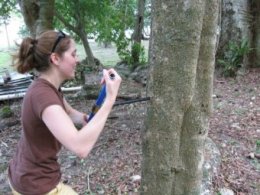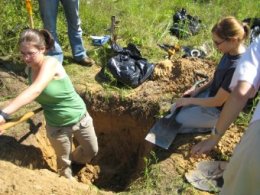Life, Climate & Environment
Primary Faculty: Corcoran, Jin, Longstaffe, Shchepetkina, Shuster, Tsujita, Webb
This broad theme involves the investigation of sedimentological, paleobiological, and climatological processes over geologic time. These processes operate within the Earth’s surface and near-surface realms. A variety of investigative techniques are employed, including field-based studies, stable isotope analysis, petrography, subsurface data analysis, major and trace element analysis, micro-imaging and numerical analysis.
These diverse techniques allow us to address a range of issues that include: sea-level change, biodiversity change, climate change, mass extinction, post-depositional processes, and lithosphere-atmosphere-biosphere interactions throughout Earth’s evolution.
The range and scope of research projects within the Earth Evolution theme is substantial, and there is major interaction and synergy between this and other research themes. However, Earth Evolution is distinguished by the fact that investigations inevitably involve the issue of change through time, whether over only a few hundred years to millions, or even billions of years.
Dr. Patricia Corcoran
Factors that control the composition of sedimentary deposits: anthropogenic activity, source, climate, transport, recycling, ancient life. Collaborative projects involve plastic pollution in sediment, soils, air, water, and biota; Precambrian to modern sedimentary systems. Analytical techniques include microscopy, Fourier transform infrared spectroscopy (FTIR), Scanning electron microscopy (SEM), and cathodoluminescence (CL) spectroscopy. Clean laboratory suite for processing samples containing microplastics.
Dr. Jisuo Jin
Ordovician-Silurian brachiopod taxonomy and diversity patterns through time; origin, radiation, mass extinction, and recovery of brachiopod faunas in the epicontinental seas of North America during the Ordovician and Silurian periods; paleoecolgy and environmental control on the evolution of brachiopod communities and faunas; comparative study of Ordovician-Silurian brachiopod faunas of North America and other regions – applications to global biodiversity patterns and paleobiogeography.
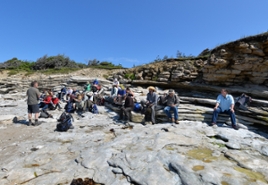
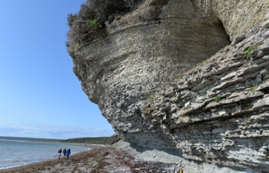
Dr. Fred Longstaffe
The use of O, H, C, and N isotopic ratios, including triple-isotope ratios of oxygen, and mineralogy to understand lower temperature lithosphere-biosphere-hydrosphere-atmosphere interactions. Large-scale fluid-rock interaction, diagenesis and alteration in sedimentary basins and other crustal rocks (Appalachian basin, Avalonia). Calibration and application of isotopic proxies (e.g., precipitation, lakewater, DIC, nitrate, cellulose, pollen, soil and sediment organic matter, shelly fauna, and teeth, bones, tusks and hair [collagen, keratin, amino acids, bioapatite phosphate and structural carbonate] of mammals – e.g., mammoths, mastodons, deer) for paleoecological and paleoclimatic reconstruction. Paleolimnology and glacial meltwater movement in the Great Lakes Basin over the last ~15,000 years (sediment cores: porewater, ostracodes, organic matter, diatoms, and clay mineralogy).
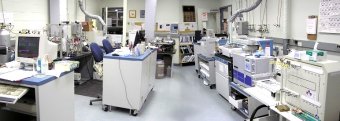
Dr. Alina Shchepetkina
Dr. Alina Shchepetkina’s scientific interests are diverse and cover various areas of sedimentary and
environmental geology. Her research utilizes field and laboratory methods, including experimental,
encompassing both modern and ancient sedimentary environments (e.g., marginal-marine, coastal, shallow- and deep-marine). Her work aims at refining facies models (analogs) for the rock record and reconstructing
paleoenvironments of deposition using a variety of proxies: detailed sedimentological and ichnological
observations, optical microscopy, CT and X-ray core scans, SEM, XRD, XRF, SWIR hyperspectral
imagery, diatom analysis, and aquarium experiments. In modern studies, the additional focus is on refining
animal-sediment relationships and environmental stresses that affect the benthic community and resulting
trace fossils.
Dr. Jeremiah Shuster
Microbes are ubiquitous in nature. They mediate mineral precipitation or dissolution within natural and engineered environments. Although these biogeochemical processes occur at the nanometer scale, they contribute to global element cycling. For example, microbes can influence the formation of biogenic rocks, such as microbialites within coastal saline lakes (Lake Clifton, Australia) and terraced iron formations within acid mine drainage environments (Rio Tinto, Spain). Geomicrobiology research at Western uses a multi-analytical approach, integrating aqueous geochemistry, high-resolution electron microscopy, and spectroscopy, to better understand fluid-microbe-mineral interactions through time. These interactions have implications for scientific and social challenges such as carbon sequestration or the remediation of acid mine drainage from legacy tailings.
Dr. Cameron Tsujita
Taphonomic (post-mortem) factors that control the preservation of both hard and soft tissues of ancient organisms, including sedimentary dynamics, bioturbation, geomicrobiological processes and later effects of diagenesis. Paleoecology of invertebrate marine communities, reconstruction of ancient marine environments, and event stratigraphy. Collaborative projects include studies of the exceptionally preserved Mazon Creek biota (Carboniferous), and paleoecological and taphonomic aspects of Paleozoic mudrocks.
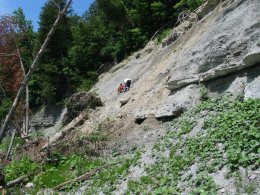
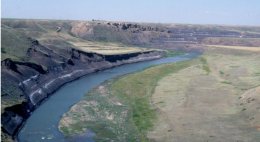
Dr. Elizabeth Webb
Development of stable-isotope biogeochemistry techniques to understand the interactions among the soil-plant-atmosphere continuum. Paleoclimate models based on the isotopic analysis of ancient plant materials (biogenic minerals and organic molecules) preserved in terrestrial soils are used to assess climate change and the evolution of biogeochemical cycles with implications for carbon sequestration, water resource availability, weathering rates, drought and fire frequency and ecosystem resilience in regions with high rates of natural or anthropogenic vegetation change.
